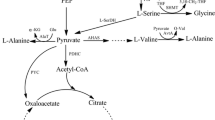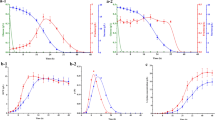Abstract
Sucrose and molasses are attractive raw materials for industrial fermentation. Although Corynebacterium glutamicum shows sucrose-utilizing activity, sucrose or molasses is only a fraction of carbon source used in the fermentation medium in most works. An engineered C. glutamicum strain was constructed for producing L-ornithine with sucrose or molasses as a sole carbon source by transferring Mannheimia succiniciproducens β-fructofuranosidase gene (sacC). The engineered strain, C. glutamicum ΔAPE6937R42 (pEC-sacC), produced 22.0 g/L of L-ornithine with sucrose as the sole carbon source, which is on par with that obtained by the parent strain C. glutamicum ΔAPE6937R42 with glucose as the sole carbon. The resulting strain C. glutamicum ΔAPE6937R42 (pEC-sacC) produced 27.0 g/L of L-ornithine with molasses as the sole carbon source, which is higher than that obtained by the parent strain C. glutamicum ΔAPE6937R42 with glucose as the sole carbon. This strategy can be applied for developing sucrose- or molasses-utilizing industrial strains.

Similar content being viewed by others
References
Becker J, Zelder O, Häfner S, Schröder H, Wittmann C (2011) From zero to hero—design-based systems metabolic engineering of Corynebacterium glutamicum for L-lysine production. Metab Eng 13:159–168
Chinard FP (1952) Photometric estimation of proline and ornithine. J Biol Chem 199:1–95
Choi DK, Ryu WS, Choi CY, Park YH (1996) Production of L-ornithine by arginine auxotrophic mutants of Brevibacterium ketoglutamicumin dual substrate limited continuous culture. J Ferment Bioeng 81:216–219
Cimino F, Maria C, Cittadini D (1964) Mechanism of the protection by L-ornithine-L-aspartate mixture and by L-arginine in ammonia intoxication. Arch Biochem Biophys 107:499–503
Engels V, Georgi T, Wendisch VF (2008) ScrB (Cg2927) is a sucrose-6-phosphate hydrolase essential for sucrose utilization by Corynebacterium glutamicum. FEMS Microbiol Lett 289:80–89
Hwang GH, Cho JY (2010) Identification of a suppressor gene for the arginine-auxotrophic argJ mutation in Corynebacterium glutamicum. J Ind Microbiol Biotechnol 37:1131–1136
Hwang GH, Cho JY (2012) Implication of gluconate kinase activity in L-ornithine biosynthesis in Corynebacterium glutamicum. J Ind Mcrobiol Biotechnol 39:1869–1874
Hwang GH, Cho JY (2014) Enhancement of L-ornithine production by disruption of three genes encoding putative oxidoreductases in Corynebacterium glutamicum. J Ind Microbiol Biotechnol 41:573–578
Hwang JH, Hwang GH, Cho JY (2008) Effect of increased glutamate availability on L-ornithine production in Corynebacterium glutamicum. J Microbiol Biotechnol 18:704–710
Jiang LY, Chen SG, Zhang YY, Liu JZ (2013a) Metabolic evolution of Corynebacterium glutamicum for increased production of L-ornithine. BMC Biotechnol 13:47
Jiang LY, Zhang YY, Li Z, Liu JZ (2013b) Metabolic engineering of Corynebacterium glutamicum for increasing the production of L-ornithine by increasing NADPH availability. J Ind Microbiol Biotechnol 40:1143–1151
Khaw TS, Katakura Y, Ninomiya K, Moukamnerd C, Kondo A, Ueda M, Shioya S (2007) Enhancement of ethanol production by promoting surface contact between starch granules and arming yeast in direct ethanol fermentation. J Biosci Bioeng 103:95–97
Kirchner O, Tauch A (2003) Tools for genetic engineering in the amino acid-producing bacterium Corynebacterium glutamicum. J Biotechnol 104:287–299
Kopsahelis N, Agouridis N, Bekatorou A, Kanellaki M (2007) Comparative study of spent grains and delignified spent grains as yeast supports for alcohol production from molasses. Bioresour Technol 98:1440–1447
Kopsahelis N, Nisiotou A, Kourkoutas Y, Panas P, Nycha GJE, Kanellaki M (2009) Molecular characterization and molasses fermentation performance of a wild yeast strain operating in an extremely wide temperature range. Bioresour Technol 100:4854–4862
Koutinas AA, Wang R, Webb C (2004) Evaluation of wheat as generic feedstock for chemical production. Ind Crop Prod 20:75–88
Lee YJ, Cho JY (2006) Genetic manipulation of a primary metabolic pathway for L-ornithine production in Escherichia coli. Biotechnol Lett 28:1849–1856
Lee HW, Yoon SJ, Jang HW, Kim CS, Kim TH, Ryu WS, Jung JK, Park YH (2000) Effects of mixing on fed-batch fermentation of L-ornithine. J Biosci Bioeng 89:539–544
Lee JW, Choi S, Park JH, Vickers CE, Nielsen LK, Lee SY (2010a) Development of sucrose-utilizing Escherichia coli K-12 strain by cloning β-fructofuranosidases and its application for L-threonine production. Appl Microbiol Biotechnol 88:905–913
Lee SY, Cho JY, Lee HJ, Kim YH, Min J (2010b) Enhancement of ornithine production in proline-supplemented Corynebacterium glutamicum by ornithine cyclodeaminase. J Microbiol Biotechnol 20:127–131
Lu DM, Jiang LY, Chen LA, Liu JZ, Mao ZW (2011) Optimization of fermentation conditions of the engineered Corynebacterium glutamicum to enhance L-ornithine production by response surface methodology. J Biotechnol Biomater 1:116. doi:10.4172/2155-952X.1000116
Lu DM, Liu JZ, Mao ZW (2012) Engineering of Corynebacterium glutamicum to enhance L-ornithine production by gene knockout and comparative proteomic analysis. Chinese J Chem Eng 20:731–739
Meiswinkel TM, Gopinath V, Lindner SN, Nampoothiri M, Wendisch VF (2012) Accelerated pentose utilization by Corynebacterium glutamicum for accelerated production lysine, glutamate, ornithine and putrescine. Microb Biotechnol 6:131–140
Puigbò P, Guzmán E, Romeu A, Garcia-Vallvé S (2007) OPTIMIZER: a web server for optimizing the codon usage of DNA sequences. Nucleic Acids Res 35:W126–W131
Renouf MA, Wegener MK, Nielsen LK (2008) An environmental life cycle assessment comparing Australian sugarcane with US corn and UK sugar beet as producers of sugars for fermentation. Biomass Bioenergy 32:1144–1155
Schneider J, Niermann K, Wendisch VF (2011) Production of the amino acids L-glutamate, L-lysine, L-ornithine and L-arginine from arabinose by recombinant Corynebacterium glutamicum. J Biotechnol 154:191–198
Seo SW, Yang JS, Kim I, Yang J, Min BE, Kim S, Jung GY (2013) Predictive design of mRNA translation initiation region to control prokaryotic translation efficiency. Metab Eng 15:67–74
Shi HP, Fishel RS, Efron DT, Williams JZ, Fishel MH, Barbul A (2002) Effect of supplemental ornithine on wound healing. J Surg Res 106:299–302
Van der Rest ME, Lange C, Molenaar D (1999) A heat shock following electroporation induces highly efficient transformation of Corynebacterium glutamicum with xenogeneic plasmid DNA. Appl Microbiol Biotechnol 52:541–545
Xu J, Zhang J, Guo Y, Zai Y, Zhang W (2013) Improvement of cell growth and L-lysine production by genetically modified Corynebacterium glutamicum during growth on molasses. J Ind Microbiol Biotechnol 40:1423–1432
Zajac A, Poprzecki S, Zebrowska A, Chalimoniuk M, Langfort J (2010) Arginine and ornithine supplementation increases growth hormone and insulin-like growth factor-1 serum levels after heavy-resistance exercise in strength-trained athletes. J Strength Cond Res 24:1082–1090
Zhang JF, Wang JB, Huang JM, Zhang J (2009) Breeding of high-yield L-ornithine-producing strain by protoplast fusion. Amino Acids Biot Resour 31:53–57
Acknowledgments
We are grateful to the National Natural Science Foundation of China (Grant No. 30970089, 20876181, 21276289), the Natural Science Foundation of Guangdong Province (No. S2011010001396), and the Key Project of the Scientific and Technical Innovation of Higher Education of Guangdong Province (2012CXZD0002) for their financial support.
Author information
Authors and Affiliations
Corresponding author
Electronic supplementary material
Below is the link to the electronic supplementary material.
ESM 1
(DOCX 16 kb)
Rights and permissions
About this article
Cite this article
Zhang, YY., Bu, YF. & Liu, JZ. Production of L-ornithine from sucrose and molasses by recombinant Corynebacterium glutamicum . Folia Microbiol 60, 393–398 (2015). https://doi.org/10.1007/s12223-014-0371-x
Received:
Accepted:
Published:
Issue Date:
DOI: https://doi.org/10.1007/s12223-014-0371-x




